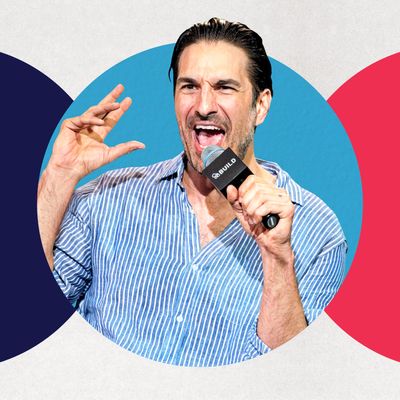
For years, Gary Gulman dissected the quotidian stuff of Gen-X consumer life — Oreos, Vanilla Ice, the Sony Discman — defending and excoriating these bits of minutiae in equal measure. As a diction-obsessed observational comic in the mold of David Brenner or Jerry Seinfeld, Gulman earned a spot on Dane Cook’s Tourgasm, became a finalist on Last Comic Standing, and appeared regularly on Conan. Then, over the course of the last decade, Gulman began telling stories. These larger tales, culled from life or flights of Gulman’s fancy, help him weave individual bits into larger tapestries of jokes; they also earn a sort of gestalt that Gulman’s work lacked while he was coming up.
Gulman’s latest album, It’s About Time, has two such big jokes that constantly spin off into giddy digressions. One, about how American states got their two-letter abbreviations, is an intricate work of imagination; the other, about an entitled woman who parks her cart in the Trader Joe’s line and disappears to grab some frozen foods, is a true-to-life experience that reveals much more about privilege, politics, and depression than it lets on. In this episode of Good One, Vulture’s podcast about jokes and the people who tell them, Gulman talks about finding his voice, mental health, and how to turn an annoyance into a 20-minute epic, dense with tangent and allusion. Listen to the episode and read a short excerpt of the discussion below. Tune in to Good One every Monday on Apple Podcasts, Spotify, or wherever you get your podcasts.
Let’s start at the beginning. At this time, were you going around living your life looking for material?
At that point I don’t think that I was living for material because most of my material had come from observations. This was my first long story joke.
So you go to Trader Joe’s …
[At] 72nd and Broadway. After a therapy session — this guy that many comedians see named Alan Lefkowitz. He started with Richard Lewis. So I was at Trader Joe’s and there were two or three elderly women ahead of me, and then there was a woman ahead of them who left her cart and was gone for a while, and to the point where the line moved forward and we went ahead of her and then she came back and she insisted on getting ahead of us again. One of the elderly women — and this is the great line that I take for myself — one of the elderly women said to her, “You went shopping.” And she resisted and she was so hostile and they just gave in, and I was so incensed and had just been empowered by a good therapy session. I decided to yell, “This isn’t fair.” And then the woman turned back to me and she said, “You’ll get over it.” I try to get in front of her and she slammed her cart into my basket and it got ugly. I went onstage that night at the Comedy Cellar and told the story, and the only thing I really had was, “You went shopping.”
My favorite part of the joke is the story of how the cashiers at Trader Joe’s handle the receipts. It’s different than almost any other joke you did at the time, which involves a long, quiet buildup that includes a list of antidepressants and a euphemism for suicide. Why that stylistic choice?
Well, I’ve never been really comfortable talking about my mental illness onstage. And then there was this opportunity where I was already doing pretty well with this joke. Then I felt comfortable with this audience and I could make myself vulnerable by talking about this rather personal thing.
Like a lot of things about jokes, it was about timing. I’d just read a New York Times op-ed by my psychiatrist. He’s a professor at Cornell and he sees patients. But he had talked about the tiny interactions during the day, how they raised your levels of dopamine and serotonin. All these things, I tried them out one night and they worked and they stuck. People laughed when I mentioned the different antidepressants that were out there, so I acknowledged that I was on them. Instead of making me embarrassed, it was very freeing.
One of the reasons I like that part of the joke so much is that pretty much my entire hour-and-a-half show is based on revealing a lot about my illness and depression and anxiety and my hospitalization. It’s called The Great Depresh, and we’re shooting it for HBO in June here in New York.
This joke’s an incredibly personal joke without being what we think of as personal comedy.
I always think of Seinfeld as being very vulnerable even though people say, “Well, you don’t really know anything about Seinfeld.” But you know that in the ’80s, when no one was talking like that, he felt these things and said them onstage to New Yorkers. I think he was very vulnerable.
There’s a definition of “personal” that was especially the vanguard around this time, which is like, Oh, I must reveal what is seen as personal. In retrospect, people that were held up as being most personal were not telling us personal things.
Right!
What is actually personal is saying, This joke is long, and it has a lot of little details, but also tells you how your brain works. That is the best art can do: You get to ride along in a person’s brain and connect the dots as they go through a thing.
Kurt Vonnegut talks about [how] reading is meditating in other people’s minds.
I nearly asked you about your state abbreviations joke. It gets talked about a lot because it felt like the height of your ability as a comedian. This felt like the most “you” joke.
It’s probably my best joke, and it’s not as popular as some of the other ones. Maybe because of where I did it, or the timing, or the fact that Patton Oswalt didn’t go on Facebook and rave about it.
When did you realize this joke is saying, “This is who I am”?
As I was writing it, I was saying, I can get everything about me into this joke. I’ve tried to do that with most of my jokes since I first started. It’s a cheat, because up until recently I didn’t want to tell you anything about me. I wanted to keep it to myself. The last Colbert show I did, I talked about all these lazy things in my life. What I really was saying, but I didn’t have the confidence, was, I’m so sick. I’m really depressed. I’m very sad and I can’t function.
On Twitter, you write a series of tips for aspiring comics. Many of them indicate that you appreciate the craft that goes into great works of art, but in interviews, I’ve heard you brusk at being called a craftsman. To me, it sounded like when you heard “craftsman,” you heard “not an artist.” But recently you tweeted this:
Where are you now with the idea?
I’ve been coming back to when I started to think of myself as an artist. I can remember the inspiration. There was this painting by Edward Hopper. It could have been in the Guggenheim, it could have been at the MoMA, but I saw it and there was a splotch of white paint on a light pole — a globe streetlight. I said, He thought about that splotch of white paint a lot. There are a lot of other areas on this painting that he made choices on. It was while I was writing this joke and I thought, I’m making something and it’s not the same. It’s more of a collage than it is a painting, but I need to be meticulous in choosing the right things to overlap with this joke because there’s a theme. Things you have to do intentionally for years will eventually become things that you do offhandedly and onstage and without really thinking about it.
One of your tips references George Carlin, who said he started producing his best work at the age of 51. You’re going to turn 49 this year, close enough to Carlin’s age, so do you think you’ve got it figured out?
Yeah, I feel terrific. I feel very creative right now, and my output has been stronger than it’s ever been. People will say, “Oh, Gary, you had a voice and you sounded like this for a long time.” That may have been the case, but I felt I was just writing joke to joke. Now I feel I have, for lack of a better term, a formula. I always think of John Singleton talking about Boyz n the Hood being the movie he went to USC film school to write, and so I feel like all these years of comedy I’ve been writing words so that I could write this depression special. The other thing I remember — Richard Price wrote the screenplay The Color of Money that Scorsese directed, so I don’t know who came up with this line — but Paul Newman says to either Tom Cruise or Tom Cruise’s girlfriend, “You have to learn to be yourself but on purpose.”


